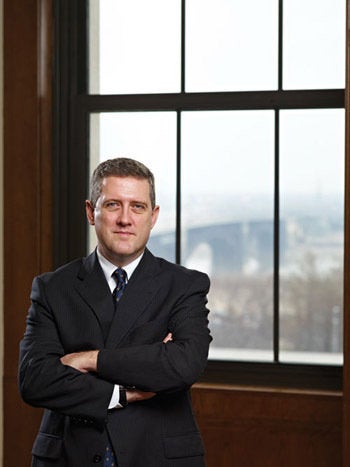
A third top Fed official is calling for megabanks to be broken up.
James Bullard, president and chief executive of the Federal Reserve Bank of St. Louis, echoed the call of Kansas City Fed President Thomas M. Hoenig and Dallas Fed President Richard W. Fisher, telling reporters that the nation's biggest banks should be busted up into pieces. The only impediment to doing so, he said, is how.
"If you had a clear road map, I'd be for it," Bullard said Thursday at the Hyman P. Minsky Conference in New York. "If there was a good way to do so, if you had a clear road map about how you were going to go about it, and why you were going to break them up in this particular way."
Bullard, Hoenig and Fisher effectively represent bankers from Middle America. Hoenig repeatedly has talked about the tilted financial playing field that benefits Wall Street banks over Main Street banks. Fisher said Wednesday that megabanks pose such a danger that they can spread "debilitating viruses throughout the financial world," reiterating his call that megabanks should be broken up.
"I have a lot of sympathy for what they're saying," Bullard said. "I do kind of agree that 'too big to fail' is 'too big to exist'. The only thing that's making me hesitate about that are the details about how you would split up firms [and] why would you make them split up one way as opposed to another way.
"I haven't seen a lot on that, but I'm very sympathetic," he said. "But the devil's in the details about how you would actually break them up."
Hoenig has called for a partial return to the Glass-Steagall Act, the Depression-era law repealed at the urging of Clinton administration officials that long separated traditional banking from capital markets activities. A restoration of that divide, plus some additional action by policymakers, will break up today's megabanks, he says.
Fisher wants an "international accord to break up these institutions into ones of more manageable size -- more manageable for both the executives of these institutions and their regulatory supervisors." But if that's not possible, the U.S. should act unilaterally and go it alone, he said. Fisher suggested a ceiling on assets placed at $100 billion.
There are 23 bank-holding companies in the U.S. with more than $100 billion in assets, according to Federal Reserve data.
The top 12 banks in the U.S. control half the country's deposits. By comparison, it took 25 banks to accomplish this feat in 2003 and 42 banks in 1998, according to a Jan. 4 research note by Jason M. Goldberg of Barclays Capital.
Bank of America, JPMorgan Chase, Citigroup and Wells Fargo collectively hold about $7.4 trillion in assets, according to the most recent regulatory filings with the Federal Reserve. That's equal to about 52 percent of the nation's estimated total output last year.
"I think they should be broken up," Hoenig said in a March interview with the Huffington Post. "I think there's no reason why as we've done in other instances of [sic] finding the right mechanism to break them into their components."
"And in doing so, I think you'll make the financial system itself more stable. I think you will make it more competitive, and I think you will have long-run benefits over our current system, [which] mixes it and therefore leads to bailouts when crises occur," Hoenig said.
Fisher said that "based on my experience at the Fed... the marginal costs of TBTF financial institutions easily dwarf their purported social and macroeconomic benefits. The risk posed by coddling TBTF banks is simply too great.
"Winston Churchill said that 'in finance, everything that is agreeable is unsound and everything that is sound is disagreeable.' I think the disagreeable but sound thing to do regarding institutions that are TBTF is to dismantle them over time into institutions that can be prudently managed and regulated across borders," Fisher said. "And this should be done before the next financial crisis, because we now know it surely cannot be done in the middle of a crisis."
That kind of fundamental reform -- and candid talk -- is largely absent in Washington, where policymakers and the majority of legislators support maintaining the dominance and size enjoyed by today's global financial institutions. At least two Clinton-era officials in office at the time Glass-Steagall was repealed -- Larry Summers and Timothy Geithner -- now serve at the highest levels in the Obama administration: Summers, as Obama's top economic adviser, serves as director of the National Economic Council while Geither is the Secretary of the Treasury.
But between Bullard, Hoenig and Fisher, at least three of 12 regional Fed presidents are calling for megabanks to be broken up. That's 25 percent of the Federal Reserve system.
